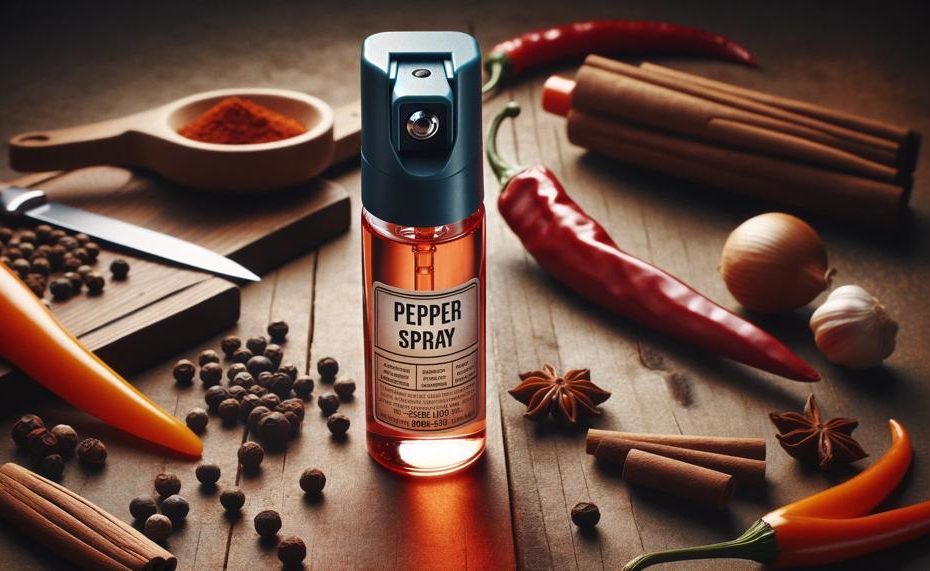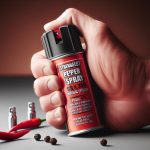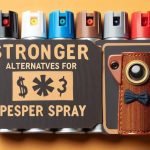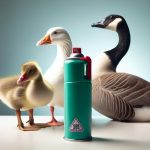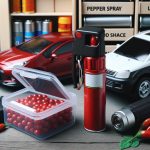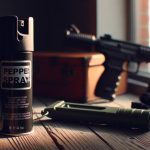Looking for a reliable way to protect yourself in potentially dangerous situations?
Pepper spray has been trusted for decades and remains one of the most effective ways to ward off attackers.
However, before you reach for that canister, it’s crucial to understand how to use it properly. In this informative blog post, we’ll cover all the essential information you need to know about effectively using pepper spray.
From its history and mechanism of action to different types and strengths, proper deployment techniques, tips for choosing the right one, and legal considerations – we’ve got you covered.
Whether you’re a college student walking home at night or a jogger on an isolated trail, having pepper spray within reach can provide peace of mind and help ensure your safety.
So let’s delve into this must-have self-defense tool and learn everything there is to know about it.
Contents
- 1 How To Use Pepper Spray Effectively?
- 2 The Legalities of Pepper Spray: State Laws and Restrictions
- 3 Choosing the Right Pepper Spray for Your Needs
- 4 Proper Techniques for Using Pepper Spray Effectively
- 5 Preparing Yourself for a Potential Attack: Awareness and Escape Routes
- 6 Using Pepper Spray as a Last Resort: When to Use It and When Not To
- 7 Post-Spray Protocol: Moving Away, Calling for Help, and Seeking Medical Attention
- 8 Conclusion
How To Use Pepper Spray Effectively?
First and foremost, it’s essential to be aware of your surroundings at all times. This means having a clear escape route in mind and staying vigilant in potential danger zones. Next, make sure you’re holding the canister correctly with your finger on the trigger. This will ensure that you can quickly and efficiently deploy the spray if needed.
When it comes time to actually use the pepper spray, aim for the attacker’s face, specifically targeting their eyes, nose, and mouth. This will cause the most discomfort and give you the best chance of escaping from the situation. It’s also important to remember that you should use short bursts of spray rather than a continuous stream. This will help conserve your supply and ensure that you’re able to spray multiple attackers if necessary.
As you spray, make sure to keep a safe distance of 6-8 feet away from the attacker. This will prevent them from grabbing or disarming you while you’re deploying the spray. After spraying, move away from the attacker and call for help immediately. It’s also crucial to seek medical attention if necessary, as pepper spray can cause serious pain and irritation.
Remember, using pepper spray effectively requires proper training and preparation. Be sure to take a training course from a professional before purchasing and using pepper spray. This will ensure that you’re fully prepared and confident in using it in a high-pressure situation.
And always remember, pepper spray should only be used for self-defense and should never be used as a form of punishment or intimidation.
The Legalities of Pepper Spray: State Laws and Restrictions
The legality of pepper spray is not a one-size-fits-all matter. Each state has its own set of regulations, specifically pertaining to its strength and size. It is imperative for individuals to conduct thorough research and fully comprehend the laws and restrictions of their state prior to purchasing and carrying pepper spray. This may entail obtaining a permit or license and exclusively purchasing from reputable dealers.
The responsible use of pepper spray cannot be emphasized enough, as it is classified as a weapon that should only be utilized in instances of self-defense. Acquiring additional training and mastering proper technique can significantly contribute towards ensuring legal and responsible use of pepper spray.
In addition to state laws, it is also important to take into account any legal implications that may arise at a federal level. For instance, using pepper spray in a manner that violates someone’s civil rights can result in legal consequences. Therefore, it is crucial to not only understand state laws but also have a comprehensive understanding of federal laws and regulations.
It is also essential to keep in mind that pepper spray is not a substitute for other self-defense methods, such as learning martial arts or carrying a concealed firearm. Pepper spray should only be used as a last resort when all other options have been exhausted.
Ultimately, being a responsible and law-abiding citizen entails understanding and adhering to the laws and regulations surrounding the use of pepper spray.
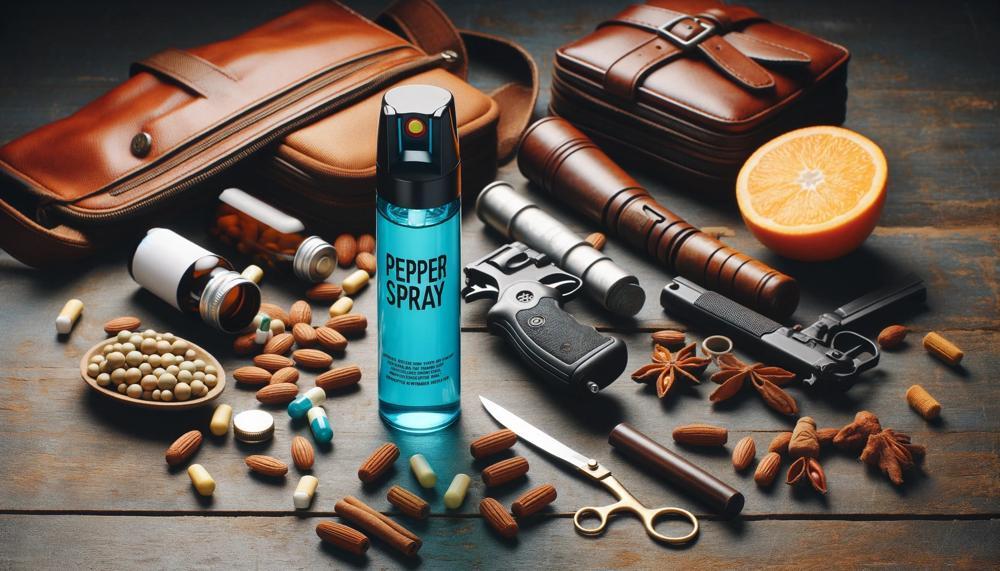
Choosing the Right Pepper Spray for Your Needs
When it comes to selecting a pepper spray for self-defense, there are several critical factors to take into account to ensure that you have the best product for your specific needs.
These aspects include legality, the percentage of oleoresin capsicum (OC), quality, size, spray type, spray pattern, range, canister size, and brand reputation.
Legality:
The first and most crucial aspect to consider is the legality of pepper spray in your state. While it is legal in some states, others may have restrictions or regulations in place, such as requiring a permit or limiting the strength of the spray. It is essential to research and understand the laws in your state before purchasing and using pepper spray.
OC Percentage:
The active ingredient in pepper spray is oleoresin capsicum (OC), which causes the burning sensation and temporary blindness.
When selecting a pepper spray, it is important to choose one with a high percentage of OC for maximum effectiveness.
Quality:
Pepper sprays come in various qualities, so it is crucial to opt for one from a reputable brand known for producing high-quality products.
Low-quality sprays may not have the desired effect and could potentially cause harm to both you and your attacker.
Size:
The size of the pepper spray should also be taken into consideration when making your decision. Smaller canisters are more compact and easier to carry but may have less spray capacity. On the other hand, larger canisters may be bulkier but can hold more spray.
Spray Type and Pattern:
Pepper sprays come in different types such as stream, fog, and gel, each with its own unique characteristics and range. Some also have specific spray patterns like cone or stream. It is essential to consider your surroundings and potential attackers when choosing a spray type and pattern.
Range:
An important factor to keep in mind is that the pepper spray you choose should have a range of at least 6 feet. This will give you enough distance from your attacker to safely use the product without getting too close.
Canister Size:
In addition to the overall size of the pepper spray product, it is also important to pay attention to the size of the canister itself. Some canisters are designed to be easily accessible and quick to use, while others may require more effort to activate.
Brand Reputation:
Lastly, it is crucial to choose a pepper spray from a reputable brand that is known for producing high-quality products.
Do your research and read reviews to ensure that you are purchasing from a trusted source.
Proper Techniques for Using Pepper Spray Effectively
Using pepper spray effectively involves precise aim, proper handling, and maintenance.
Let’s take a closer look at each aspect to master the proper techniques of using pepper spray.
Aim for the Attacker’s Face:
- Take aim at the attacker’s face: The objective is to spray the attacker in the face, creating an opportunity to escape. Focus on the eyes, nose, and mouth.
- Utilize short bursts: Do not continuously spray as this can quickly deplete your pepper spray. Short bursts provide enough time for your escape while also preserving your pepper spray.
Handling and Precautions:
- Prevent contact with skin and eyes: Pepper spray is a potent irritant that can cause intense burning and temporary blindness. Avoid accidental exposure by refraining from touching your face or eyes while handling pepper spray.
- Practice with water-filled sprays: Before carrying pepper spray for self-defense, familiarize yourself with its use. Practice spraying water-filled sprays to get accustomed to the pressure and pattern.
- Use only for self-defense purposes: Pepper spray should only be used as a last resort in situations of imminent danger. Do not use it for any other purpose.
Maintenance:
- Check expiration date: Pepper spray has an expiration date and may lose its potency over time. Regularly check the expiration date and replace it when necessary.
- Conduct periodic test sprays: To ensure the proper functioning of your pepper spray, perform test sprays in a well-ventilated area.
- Store in a cool, dry place: Proper storage is crucial in maintaining the effectiveness of your pepper spray. Keep it in a cool, dry place out of children’s reach.
Remember that pepper spray is just one tool in your safety arsenal and should be used responsibly. It is also important to check the legality of carrying pepper spray in your area and only use it as a last resort in dangerous situations. By following these proper techniques and precautions, you can effectively use pepper spray as a self-defense tool to protect yourself in times of need.
Additionally, it is crucial to note that pepper spray’s effectiveness can vary depending on the type and concentration used. It is recommended to do thorough research and consult with professionals before purchasing and using pepper spray for self-defense. Moreover, practicing proper handling techniques can make all the difference in a real-life situation. Familiarizing yourself with the spray’s pressure and pattern can give you more confidence and accuracy when using it in a dangerous situation.
Preparing Yourself for a Potential Attack: Awareness and Escape Routes
| Tips for Boosting Your Awareness: | ||
| Keep yourself alert and vigilant at all times, especially when in areas with a high crime rate. | ||
| Trust your gut and avoid places that feel unsafe or uncomfortable. | ||
| Stay on the lookout for any suspicious individuals or activities. | ||
| Be cautious when walking alone, particularly at night. | ||
| Avoid getting distracted by headphones or your phone while walking in public. | ||
| Get familiar with the layout of the area you are in and potential escape routes. | ||
Using Pepper Spray as a Last Resort: When to Use It and When Not To
Pepper spray can be a highly effective means of self-defense in certain situations, but it is crucial to understand when it is appropriate to use and when it should be avoided.
Here are some guidelines to consider when deciding whether or not to use pepper spray as a form of protection.
When to Use Pepper Spray:
- The attacker poses a serious threat of harm or injury: If you are confronted by an attacker who is threatening to cause you significant harm or injury, pepper spray can be a valuable tool for defending yourself.
- The attacker is armed: In the event that the attacker has a weapon, such as a knife or gun, pepper spray offers a way to protect yourself without resorting to lethal force.
- The attacker is substantially larger in size or has specialized training that makes them more dangerous: In situations where the attacker is significantly larger than you or has specific training that makes them more dangerous, pepper spray can help level the playing field and give you a chance to escape.
- The attacker is also using pepper spray: If the attacker is deploying pepper spray against you, it may be necessary for you to do the same in order to protect yourself.
- There are multiple attackers: When faced with multiple attackers, pepper spray can be an effective means of defending yourself against all of them at once.
When to Avoid Using Pepper Spray:
- Using pepper spray as a first response: It is important to remember that pepper spray should only be used as a last resort. Before turning to pepper spray, try other de-escalation tactics such as calling for help or utilizing physical barriers.
- Using pepper spray in non-life threatening situations: Pepper spray should only be used in situations where your life or safety is at risk. It should not be employed as a form of punishment or for protecting property.
- Using pepper spray on someone you simply dislike: Pepper spray should only be used in self-defense against an attacker. It should not be used on someone simply because you have a personal dislike for them.
Post-Spray Protocol: Moving Away, Calling for Help, and Seeking Medical Attention
After being exposed to pepper spray, it is crucial to follow these steps for your safety:
- Move to a well-ventilated area: As soon as possible, move away from the source of pepper spray and into an open area with fresh air.
- Keep your eyes open: Despite the burning sensation, try to avoid closing your eyes to help flush out the irritant.
- Do not rub your eyes: Instead, gently rinse them with clean water to avoid worsening the effects.
- Remove contaminated clothing: If your clothes have come into contact with the spray, carefully remove them to prevent further exposure.
- Seek medical attention: It is advisable to seek medical attention if you experience severe symptoms or have pre-existing respiratory conditions for appropriate treatment.
- Flush with water: Fill a basin or sink with cool water and submerge affected areas for a few minutes to neutralize the spray.
- Water and antacid solution: Mix one part liquid antacid with four parts water and apply it onto affected areas for relief.
- Milk or dairy products: Soak a cloth in cold milk or yogurt and apply it onto affected areas for soothing relief.
- Lemon juice: Dip a cloth in lemon juice and gently rub onto affected areas for its acidic properties that neutralize capsaicin.
- Take a shower: Adjust the water temperature to cool or lukewarm and gently wash affected areas with mild soap or body wash.
- Avoid vinegar: While commonly believed to neutralize pepper spray, vinegar may not be effective in providing relief compared to other methods mentioned above.
- Recovery time varies: Effects typically subside within 30 minutes to a few hours, but residual discomfort may persist longer depending on individual sensitivity.
- Eye drops are not recommended: Instead, flush eyes with clean water to remove the spray.
- Seek medical attention for severe symptoms: Difficulty breathing, excessive swelling, or persistent pain may require medical treatment.
- Avoid wearing contact lenses: If exposed to pepper spray, remove and rinse lenses before reinserting them.
- Prioritize safety and seek medical attention if necessary: Knowing how to properly treat pepper spray exposure can alleviate discomfort and aid in a speedy recovery.
Remember to always prioritize your safety and seek medical attention if necessary. As the famous author Grant Cardone once said, “Success is your duty, obligation, and responsibility.” This also applies to taking care of yourself after being exposed to pepper spray.
It is important to move to a well-ventilated area and keep your eyes open to flush out the irritant. Do not rub your eyes and remove any contaminated clothing.
Seeking medical attention is crucial, especially if you experience severe symptoms or have pre-existing respiratory conditions.
Flushing with water, applying antacid solution or dairy products, and using lemon juice can help alleviate discomfort. However, avoid using vinegar as it may not be effective in providing relief.
Conclusion
In conclusion, pepper spray is a potent and dependable self-defense tool that can offer a sense of security and safeguard you in potentially perilous situations. However, knowing how to use it effectively is crucial.
This blog post has covered all the essential information you need to know about using pepper spray – from its history and mechanism of action to selecting the right type and strength, proper deployment techniques, and legal considerations.
Always remain vigilant of your surroundings, hold the canister correctly, aim for the attacker’s face with short bursts of spray, and maintain a safe distance. Additionally, be aware of state laws and restrictions when purchasing pepper spray and only use it as a last resort for self-defense.
By following these guidelines, you can confidently utilize pepper spray as a means of protection and ensure your safety in critical situations.
However, remember that pepper spray is just one tool in your safety arsenal. Trusting your instincts, staying alert at all times, and having an escape plan in mind can also help prevent potential attacks.
Avoiding unsafe areas whenever possible is also crucial. By incorporating these precautions into your daily routine, you can feel more prepared and confident in protecting yourself from harm.
